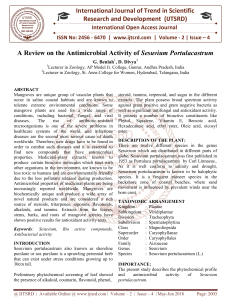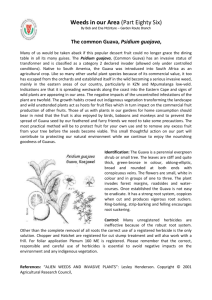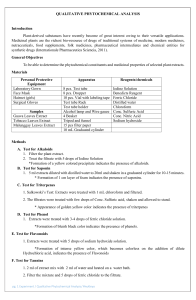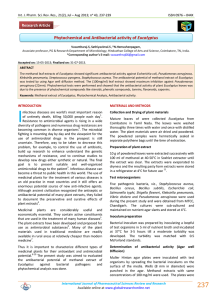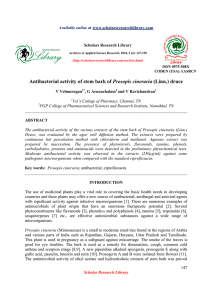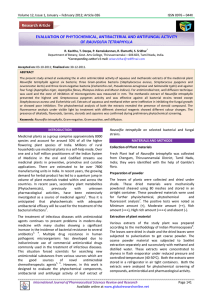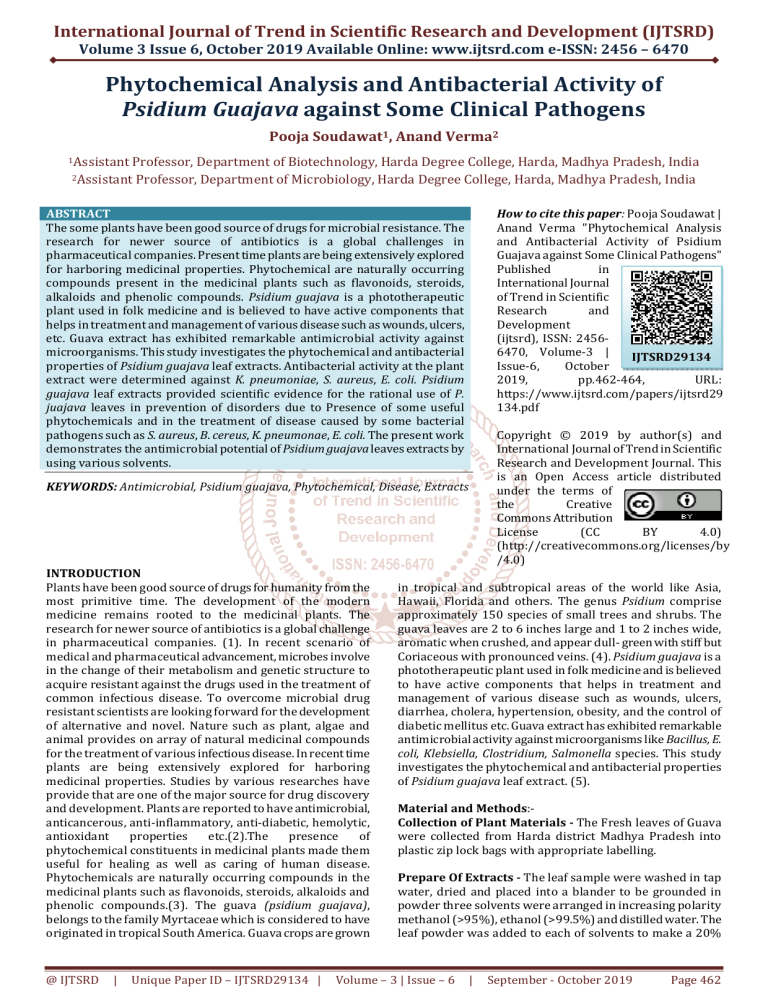
International Journal of Trend in Scientific Research and Development (IJTSRD)
Volume 3 Issue 6, October 2019 Available Online: www.ijtsrd.com e-ISSN: 2456 – 6470
Phytochemical Analysis and Antibacterial Activity of
Psidium Guajava against Some Clinical Pathogens
Pooja Soudawat1, Anand Verma2
1Assistant
Professor, Department of Biotechnology, Harda Degree College, Harda, Madhya Pradesh, India
Professor, Department of Microbiology, Harda Degree College, Harda, Madhya Pradesh, India
2Assistant
How to cite this paper: Pooja Soudawat |
Anand Verma "Phytochemical Analysis
and Antibacterial Activity of Psidium
Guajava against Some Clinical Pathogens"
Published
in
International Journal
of Trend in Scientific
Research
and
Development
(ijtsrd), ISSN: 24566470, Volume-3 |
IJTSRD29134
Issue-6,
October
2019,
pp.462-464,
URL:
https://www.ijtsrd.com/papers/ijtsrd29
134.pdf
ABSTRACT
The some plants have been good source of drugs for microbial resistance. The
research for newer source of antibiotics is a global challenges in
pharmaceutical companies. Present time plants are being extensively explored
for harboring medicinal properties. Phytochemical are naturally occurring
compounds present in the medicinal plants such as flavonoids, steroids,
alkaloids and phenolic compounds. Psidium guajava is a phototherapeutic
plant used in folk medicine and is believed to have active components that
helps in treatment and management of various disease such as wounds, ulcers,
etc. Guava extract has exhibited remarkable antimicrobial activity against
microorganisms. This study investigates the phytochemical and antibacterial
properties of Psidium guajava leaf extracts. Antibacterial activity at the plant
extract were determined against K. pneumoniae, S. aureus, E. coli. Psidium
guajava leaf extracts provided scientific evidence for the rational use of P.
juajava leaves in prevention of disorders due to Presence of some useful
phytochemicals and in the treatment of disease caused by some bacterial
pathogens such as S. aureus, B. cereus, K. pneumonae, E. coli. The present work
demonstrates the antimicrobial potential of Psidium guajava leaves extracts by
using various solvents.
Copyright © 2019 by author(s) and
International Journal of Trend in Scientific
Research and Development Journal. This
is an Open Access article distributed
under the terms of
the
Creative
Commons Attribution
License
(CC
BY
4.0)
(http://creativecommons.org/licenses/by
/4.0)
KEYWORDS: Antimicrobial, Psidium guajava, Phytochemical, Disease, Extracts
INTRODUCTION
Plants have been good source of drugs for humanity from the
most primitive time. The development of the modern
medicine remains rooted to the medicinal plants. The
research for newer source of antibiotics is a global challenge
in pharmaceutical companies. (1). In recent scenario of
medical and pharmaceutical advancement, microbes involve
in the change of their metabolism and genetic structure to
acquire resistant against the drugs used in the treatment of
common infectious disease. To overcome microbial drug
resistant scientists are looking forward for the development
of alternative and novel. Nature such as plant, algae and
animal provides on array of natural medicinal compounds
for the treatment of various infectious disease. In recent time
plants are being extensively explored for harboring
medicinal properties. Studies by various researches have
provide that are one of the major source for drug discovery
and development. Plants are reported to have antimicrobial,
anticancerous, anti-inflammatory, anti-diabetic, hemolytic,
antioxidant
properties
etc.(2).The
presence
of
phytochemical constituents in medicinal plants made them
useful for healing as well as caring of human disease.
Phytochemicals are naturally occurring compounds in the
medicinal plants such as flavonoids, steroids, alkaloids and
phenolic compounds.(3). The guava (psidium guajava),
belongs to the family Myrtaceae which is considered to have
originated in tropical South America. Guava crops are grown
@ IJTSRD
|
Unique Paper ID – IJTSRD29134 |
in tropical and subtropical areas of the world like Asia,
Hawaii, Florida and others. The genus Psidium comprise
approximately 150 species of small trees and shrubs. The
guava leaves are 2 to 6 inches large and 1 to 2 inches wide,
aromatic when crushed, and appear dull- green with stiff but
Coriaceous with pronounced veins. (4). Psidium guajava is a
phototherapeutic plant used in folk medicine and is believed
to have active components that helps in treatment and
management of various disease such as wounds, ulcers,
diarrhea, cholera, hypertension, obesity, and the control of
diabetic mellitus etc. Guava extract has exhibited remarkable
antimicrobial activity against microorganisms like Bacillus, E.
coli, Klebsiella, Clostridium, Salmonella species. This study
investigates the phytochemical and antibacterial properties
of Psidium guajava leaf extract. (5).
Material and Methods:Collection of Plant Materials - The Fresh leaves of Guava
were collected from Harda district Madhya Pradesh into
plastic zip lock bags with appropriate labelling.
Prepare Of Extracts - The leaf sample were washed in tap
water, dried and placed into a blander to be grounded in
powder three solvents were arranged in increasing polarity
methanol (>95%), ethanol (>99.5%) and distilled water. The
leaf powder was added to each of solvents to make a 20%
Volume – 3 | Issue – 6
|
September - October 2019
Page 462
International Journal of Trend in Scientific Research and Development (IJTSRD) @ www.ijtsrd.com eISSN: 2456-6470
concentration. The mixers were made in sterile flask for 3
days .The flasks were placed on a platform shake at 70 rpm.
After 3 days of soaking in solvents the mixtures were
transferred to 50 ml tubes and centrifuged for 10 min. at
4,000 rpm at 25℃. The supernatant was collected and
started at 4℃ until use.(6,7)
Phytochemical Analysis –
Test for Saponin - Added 2ml distilled water in the extracts
suspended in Ethanol and was shaken vigorously. The
formation of foam layer indicate the presence at saponins.
(8)
Test for Terpenoids - 1ml at acetic anhydride at 5 drop of
concentrated sulphuric acid as added to the extracts. A
colour change from violet to blue confirm the presence of
steroids and the formation of blue-green ring indicates the
presence of terpenoids.
Test for tannins - extracts were treated with 1ml of 5%
ferric chloride. Presence of tannin was indicated by the
formation of bluish black or greenish Black precipitate. (9)
Test for glycoside - Extract was mixed with 2 mL of glacial
acetic acid containing drops of 2% FeCl3 the mixture was
poured into another tube containing 2ml at concentrated
sulphuric acid. A brown ring at the interphase indicates the
presence of glycosides.(10)
Test for flavonoids - Few fragments of magnesium metal
ribbon (3-4 pieces) was added to 1 ml of the extracts,
followed by drop wise addition of concentrated hydrochloric
acid. Formation of pink or red colour indicated the presence
of Flavonoids.
Test of isolation - The following four clinical isolate of
Bactria were used for the study Staphylococcus aureus,
Klebsillea pneumoniae, Bacillus cereus, E. coli. All these
cultures were maintained on nutrient agar plates at 4℃.
(11,12)
Antibacterial susceptibility test- The plant extracts
Antimicrobial activities of the plant extract was tested using
well diffusion method. Were tested on Mueller Hinton II
plates to detect the presence of antibacterial activity. Wells
were mode on the Mueller Hinton agar surface with 5mm
cork borer. The extract were poured in the well using sterile
syringe. The plates were incubated at 37℃ for 24 hrs. The
plates were observed for the zone formation around the well
and were measured in millimetre (mm) ciproflaxin (5mg)
was used as control. (13, 14)
Results and Discussion - The main object of present study
was to evaluate the phytochemical analysis and antibacterial
activity of P. guajava leaves. The result obtained in the
present study provides a scientific support to use at plant in
the treatment of microbial disease.
The qualitative screening at phytochemical properties of P.
guajava leave extracts showed the presence of moderate
quantities (+) and large quantities at Saponins, Terpenoids,
Tannis, Glycoside, Flavonoids in the different solvents used.
Table – 1 Phytochemical test on solvents fractions at P. guajava leave extracts
Fraction Saponins Terpenoids Tannins Glycoside Flavonoids
Methanol
+
+
++
+
++
Ethanol
+
+
+
Aqueous
+
+
+
+
+
- = Absent, + = Present in moderate Quantity. ++ =Present in large Quantity
The analysis of the plant extracts revealed the presence of phytochemical which are known to exhibit medical and physiological
activities. For example Saponins which are glycoside have been found to have inhibitory effect on gram positive bacteria S.
aureus. Terpenoids mainly used for their aromatic qualities have also been found to be potential agents against inhibition
bacteria. Tannins are polyphenolic compound that bind to proline rich protein that interferes with protein synthesis and has
shown to have antibacterial activity.
The antibacterial activity at the P. guajave leaves extract was quantitatively assessed by the presence or absence at inhibition
zone and diameter respectively. Antibacterial activity at the plant extract were determined by well diffusion method against
test bacteria colonies. The leaf of ethenolic and aqueous extract showed inhibition activity on K. preumoniae was (11mm) ;
Methanol extract showed activity on and S. aureus (12mm) B. cereus (8.29mm), E. coli (2.0mm) and ethanol extract showed
activity on S. aureus (10mm), B. cereus (6.9mm) and E. coli (14mm)
Table – 2 Antibacterial analysis P. guajava leaf extract.
Leaf extract
S. No Test organism
Methanol Ethanol Aqueous
1.
S. aureus
12 mm
10 mm
2.
K. pneumoniae
12 mm
11mm
3.
B. cereus
8.29 mm
6.9 mm
4.
E. coli
2.0 mm
14 mm
Zone of inhibition in mm
Conclusion:
The phytochemical and antimicrobial studies of P. guajava
leaf extracts provided scientific evidence for the rationale
use of P. juajava leaves in prevention of disorders due to
Presence of some useful phytochemicals and in the
@ IJTSRD
|
Unique Paper ID – IJTSRD29134 |
treatment of disease caused by some Bacterial pathogens
such as B. aureus, B. cereus, K. pneumonae, E-coli. The present
work demonstrates the antimicrobial potential of Psidium
guajava leaves extract by using various solvents. The results
Volume – 3 | Issue – 6
|
September - October 2019
Page 463
International Journal of Trend in Scientific Research and Development (IJTSRD) @ www.ijtsrd.com eISSN: 2456-6470
indicate that ethanol and methanol are better than aqueous
solvent for the extraction of antibacterial properties of
guava. The antimicrobial activity of ethanolic and methanolic
extract of the plant of the selected bacterial pathogens were
identified. Guava fruits Recommended to take daily for good
health.
study”, International Journal of pharmaceutical
sciences Review and Research”, Vol. 4, pp. 24.
[6] Edeoga H. O., Okwu D. E. and Mbaebie B. O (2005)
“Phytochemical contituents of some Nigerian medicinal
plants. African Journal of Biotechnology Vol. 4, pp. 685688.
Acknowledgement
The author is thankful to Mr Girish Sinhal and Mrs. Abhilasha
Sinhal Directors of Harda Degree College, Harda for
providing necessary laboratory facility, and thankful to Dr
R.K. Patil Principal Harda Degree College, Harda for giving
moral support for research work.
[7] Abdelrahim S. I., A. Z. Almagboul,Omer M. E. A (2002)
“Antimicrobial activity of Psidium guajava L”.
Fitoterapia, Vol.73, pp. 713-715.
Reference:
[1] Jose S., Sujatha (2016) “Antibacterial property of
methanloic extracts Gliricidia sepium against some
human pathogen”, International Journal of Advanced
Science and Research, Vol.1, pp. 16-18.
[9] Begum S., Hassan S. I. and Siddiqui S.B. (2002) “Two
new triterpenoids from the fresh leaves of Psidium
guajava”, Planta Medica, Vol. 68, pp. 1149-1152.
[2] Muhammad S., Abdullah, Ali M. (2019) “Antibacterial
activity of Psidium guajava leaf and stem bark extracts
against clinical isolates of Staphylococcus aureus and
salmonella typhi”, International Journal of Research in
Pharmacy and Biosciences, Vol.6, pp. 11-17.
[3] Biswas B., Rogers Kimberly (2013) “Antimicrobial
activities of leaf extracts of guava (Psidium guajava L.)
on two gram negative and gram positive bacteria”,
International Journal of Microbiology, Vol. 2013 ,pp. 7.
[4] Kenneth E., Paul Tsaku (2017), “Phytochemical
analysis and antibacterial activity of Psidium guajava L.
leaf extracts” GSC Biological and pharmaceutical, Vol.2,
pp. 13-19.
[5] Kumar G., Karthik L. (2010) “Antibacterial activity of
aqueous of Calotropic gigantea leaves- an in vitro
@ IJTSRD
|
Unique Paper ID – IJTSRD29134 |
[8] Karawaya M. S., Wahab S. N., Hifnawy M. S. (1999)
“Essential oil of Egtptian guajava leaves”, Natural
Product Research, Vol. 40, pp. 209-216.
[10] Scalbert A. (1991) “Antimicrobial properties of
tannins”, Phytochemistry, Vol.30, pp. 3875-3883.
[11] Ulubelen A. (2003) “Cardioactive and antibacterial
terpenoids from some Salvia species”, phytochemistry,
Vol. 64, pp. 395-399.
[12] Cowan M. M. (1999) “Plant products as antimicrobial
agents”, Clinical Microbiology Reviews, Vol.12, pp. 564582.
[13] Joseph B. and Priya R. M. (2011) “Review of nutritional,
medicinal and pharmacological properties of Guava”,
International journal of Pharma Bioscience Vol. 2.
[14] Elekwa I., Okereke S. C. and Ekpo B.O. (2009)
“Preliminary phytochemical and antimicrobial
investigation of the stem bark and leaves od Psidium
guajava L”. Journal of medicinal plants research, Vol.3,
pp. 45-48.
Volume – 3 | Issue – 6
|
September - October 2019
Page 464

